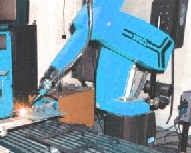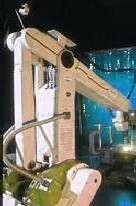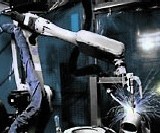|
Home
Failure Analysis
TIG Welding
MIG Welding
Flux Cored Welding
Stick Welding
SAW
Resistance Welding
Electron Beam Welding
Robotic Welding
Brazing & Soldering
Expert Witness
Experience
Fees
Links
Distortion
Discontinuities
Alloy Selection
Steel
Stainless
Steel
Aluminum
Section
IX of the ASME BPVC
ASME
P-Numbers
Structural
Welding
| |
Robotic Welding
| There
are two popular types of industrial welding robots. The two are
articulating robots and rectilinear robots. Robotics control the movement
of a rotating wrist in space. A description of some of these welding robots
are described below:
Rectilinear robots
move in line in any of three axes (X, Y, Z). In addition to linear movement
of the robot along axes there is a wrist attached to the robot to allow
rotational movement. This creates a robotic working zone that is box
shaped.
Articulating
robots employ arms and rotating joints. These robots move like a human arm
with a rotating wrist at the end. This creates an irregularly shaped
robotic working zone. |


|
There are many factors that need
to be considered when setting up a robotic welding facility. Robotic welding
needs to be engineered differently than manual welding. Some of the
consideration for a robotic welding facility are listed below:
- Accuracy and
repeatability
- Number of axes
- Reliability
- Fixtures
-
Programming
- Seam
tracking systems
|
- Maintenance
- Controls
- Weld
monitors
- Arc welding
equipment
-
Positioners
- Part
transfer
|
| A
robotic welding system may perform more repeat ably than a manual welder
because of the monotony of the task. However, robots may necessitate
regular recalibration or reprogramming. |

|
Robots should have the
number of axes necessary to permit the proper range of motion. The robot arm
should be able to approach the work from multiple angles.
Robotic welding
systems are able to operate continuously, provided appropriate maintenance
procedures are adhered to. Continuous production line interruptions can be
minimized with proper robotic system design. Planning for the following
contingencies needs to be completed:
- Rapid
substitution of the inoperable robots.
- Installing
backup robots in the production line
-
Redistributing the welding of broken robots to functioning robots close by
Contact Information
- Telephone
-
407-880-4945 -------- (Consulting is only available for customers)
- FAX
-
- Postal address
-
- Electronic mail
- General Information:
bob@WeldingEngineer.com
Customer Support:
bob@WeldingEngineer.com
Webmaster:
|
![]()